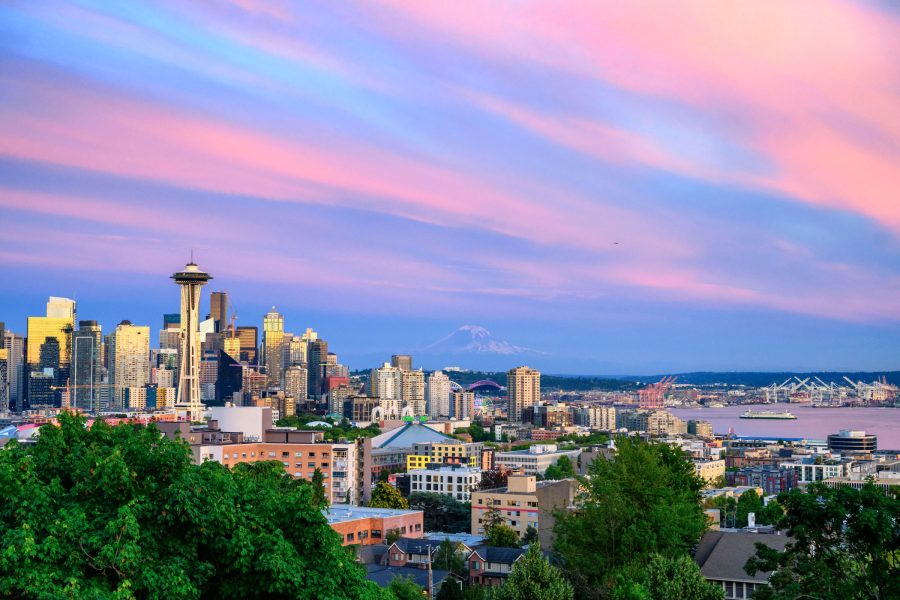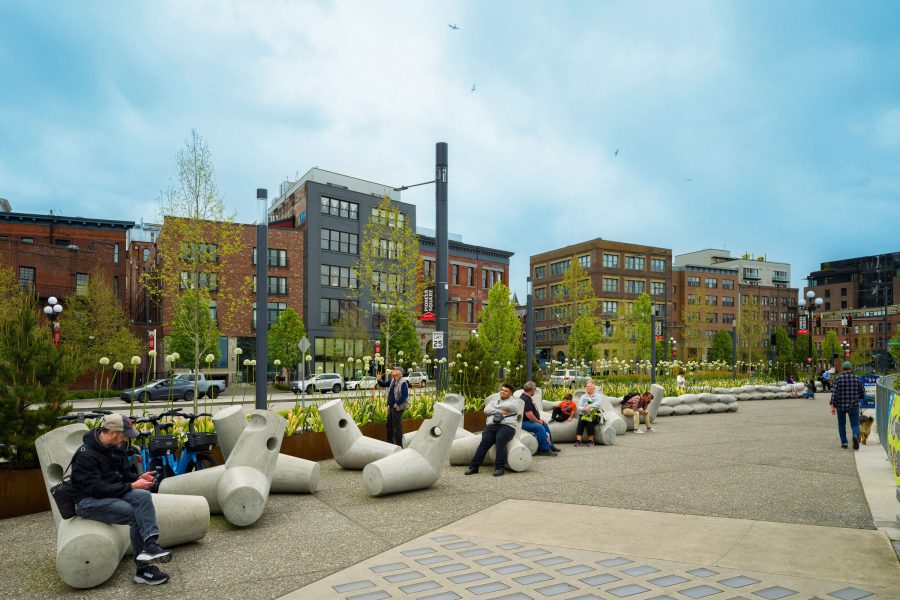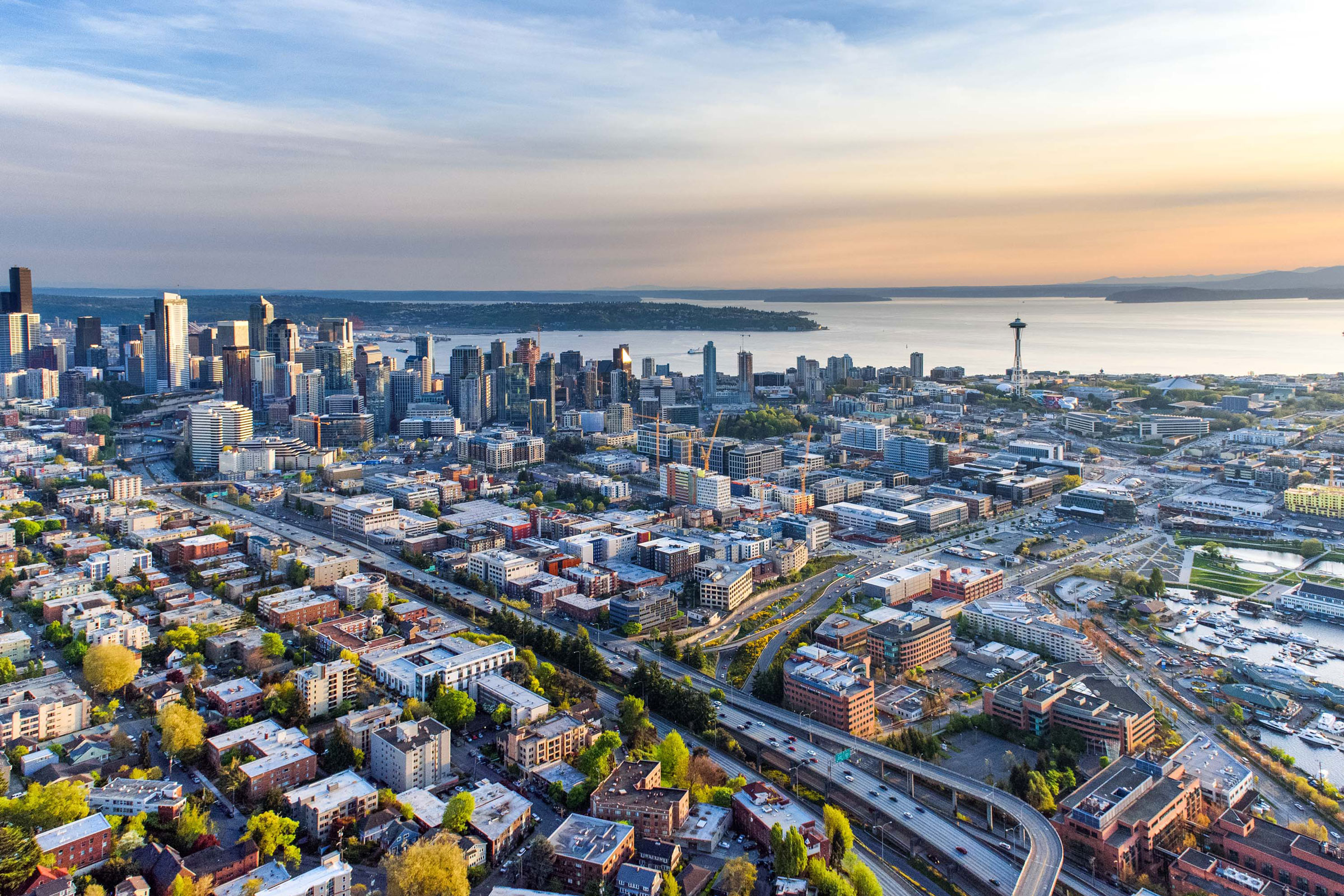Story at a glance:
- The Emerald City is a breeding ground for innovation in the built environment.
- The passage of Seattle’s Building Emissions Performance Standard codifies the city’s steps toward carbon neutrality.
- Read more about some of the latest sustainable projects in Seattle, including Amazon Frontier, the Maritime Innovation Center, an expansion at Seattle-Tacoma International Airport, The Jack, Fairmont Olympic Hotel, and the Climate Pledge Arena.
In a hyperpolarized era Seattle’s commitment to climate response continues to inspire the Emerald City—long a bastion of sustainability and environmental innovation.
“Climate is one of those things that people across the city, across sectors, have a lot of civic engagement for,” says Jessyn Farrell, director of the Office of Sustainability & Environment (OSE) for the City of Seattle and a former state legislator for the North Seattle area. “Perhaps not unity, but definitely a sense of purpose.”
Ferrell’s work at OSE is to bring people and sectors together around big ideas. She leads a mayoral office built to drive climate strategy across city departments, coordinate innovation, pilot new programs, and scale those ideas to bigger city programs across transportation, energy, environment, and, of course, buildings sectors. But in Seattle the drive to combat climate change isn’t limited to technocratic innovation and the latest in emissions reduction; it’s about people.
“Our core services go deep into climate justice and how we can cater to people in our community bearing the brunt of the climate crisis,” Farrell says. “Within that we’re reducing emissions from buildings and transportation as fast as we can as well as supporting our communities by ensuring ample tree canopy and working on food systems.”
Buildings make up more than 30% of Seattle’s overall emissions. The passage of Seattle’s Building Emissions Performance Standard codifies the city’s steps toward carbon neutrality by requiring nonresidential and multi-family buildings, new and old, that are more than 20,000 square feet to reach net zero by 2050.
The standard requires progressive decarbonization over five-year intervals starting in 2030 and addresses the tension between standardizing a predictable regulatory environment with the fact that every building is different by creating various compliance pathways based on the specifics of the building at hand. “We’ve allowed for lots of flexibility, but we’re also requiring more information from building owners,” Farrell says.
The city estimates the policy will reduce Seattle’s emissions by 27% by 2050.

Photo by Tim Durkan
Even as Seattle drives policy standards to support green design in the cities’ largest buildings, Seattle is also on a path to decarbonize residential homes currently heated by oil by 2030. Next steps in residential decarbonization are to move beyond transitioning from oil heating to electrifying homes heated by natural gas (a heat source long considered a “bridge fuel” in the fight against climate change, and now on the chopping block as more information about fuel’s contribution to climate emissions comes to light).
The city’s work on its building emissions standard is a point of pride in Farrell’s work. “In the midst of a challenging downtown recovery post-pandemic, we got building owners into a space that they were willing to work with us,” she says. “There’s a civic culture in Seattle that really cares about climate change and climate issues, and being able to lean into that really matters.”
She credits success to her office staff’s deep listening skills, political leadership from the mayor’s office, and good old-fashioned negotiating skills and creativity. “When things are polarized, sometimes inventing a new way of thinking of things helps us all achieve our goals.”
What’s next? Farrell wants to scale green building trends—use of materials like engineered wood products and low carbon cement as well as green roof requirements. “There’s a whole world of materials the city doesn’t do a bunch with yet, but private developers are working with them; the city needs to figure out how to support and expand those efforts.”
What do we need to do in the built environment to make sure those things are easy to engage with?
One example has been Seattle’s Living Building Pilot program, which provides incentives to developers to reach for the Living Building Challenge, a green building certification program managed by the International Living Future Institute.
To support her office’s work Farrell looks in part to opportunities for state and federal funds. Washington’s leading Climate Commitment Act, which requires Washington cities and the state’s largest emitters to reduce climate pollution at the source or purchase allowances at auction reinvests funds into projects like those OSE is working on. Meanwhile the federal Inflation Reduction Act also provides funding to the city’s buildings program. “Building owners need help to do this. It’s expensive, challenging, and difficult. So we’re hustling to go after grants.”
Seattle’s biggest challenge, she says, will be getting a handle on transportation emissions, especially after the pandemic. “We’re just not commuting how we were before,” she says. “Our bus systems and trip reduction programs have to be realigned. Transportation electrification will be a place building owners can assist and be forward-thinking.”
Part of that will be reimagining how the city interacts with its electrical grid. As Seattle electrifies buildings and transportation, new stressors will be placed on the grid. “Energy efficiency is a key part,” she says. “Making sure the grid can handle this massive transition is important. Car charging, delivery charging, zero emissions delivery writ large, bike delivery—what do we need to do in the built environment to make sure those things are easy to engage with?”

Photo courtesy of the City of Seattle
The future looks bright for Seattle, and more spacious, as the city embarks on not just a greening of its buildings and transportation sector, but also a reimagining and revitalization of its waterfront just a few years after an elevated double-decker highway that cut the city off from Elliott Bay was moved underground. “What is it about Seattle that creates a propensity for civic action? It’s in part this beautiful natural environment we live in,” Farrell says.
Standing on First Avenue looking west toward the water, you can sense a new quiet. View corridors that were formerly blocked are restored. Residents delight in new shoreline and places to connect with the water, while a sea wall rebuild project fosters habitat for the many creatures that live in Puget Sound. Amenities like access to Pike Place or to the state ferry system are that much closer. “It is transformative,” Farrell says. We are just starting to feel that.”



